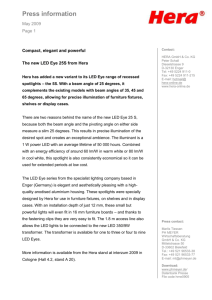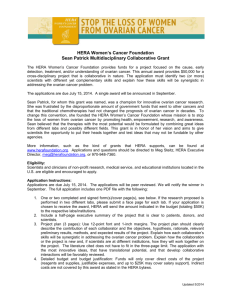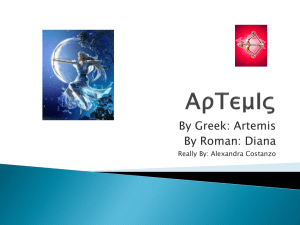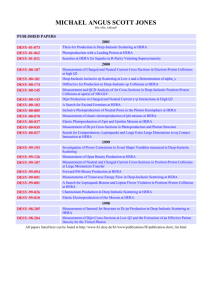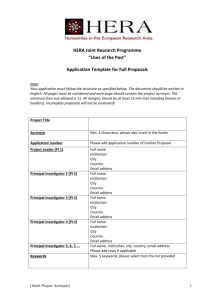Part 1
advertisement
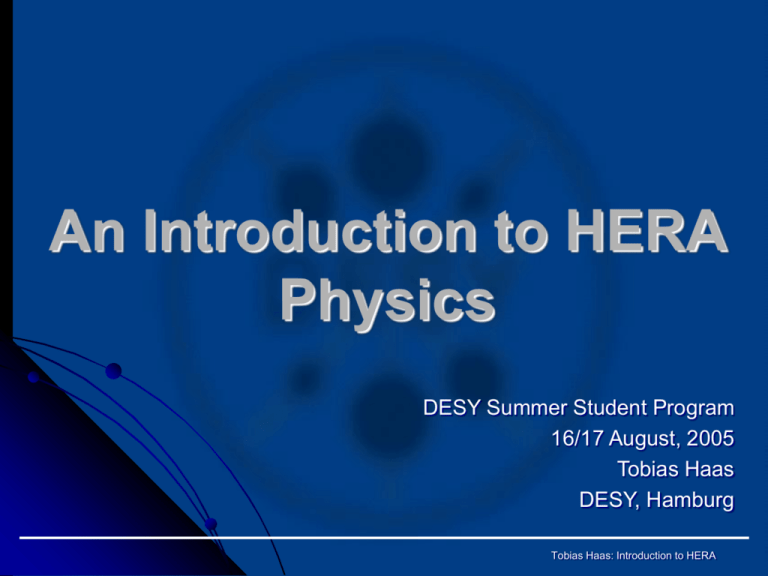
An Introduction to HERA Physics DESY Summer Student Program 16/17 August, 2005 Tobias Haas DESY, Hamburg Tobias Haas: Introduction to HERA Part 1: What is HERA? Structure Function Formalism Kinematics Structure Function Evolution (RGE/DGLAP) Part 2: Selected HERA I Results: © G. Larson: “The Far Side” Overview Structure Functions High Q2 and EW Jets and the strong coupling αS Part 3: Why HERA II: High lumi/polarization EW precision measurements Tobias Haas: Introduction to HERA Part 1 Tobias Haas: Introduction to HERA What is HERA? © G. Larson: “The Far Side” Tobias Haas: Introduction to HERA Physics @ Colliders + Simple initial state + Clean final states + Little background - Limited energy • e.g. LEP(200 GeV), ILC(1 TeV) e+ e- p p + High energy (no synch rad) - Complicated initial state - Large and complicated backgrounds - e.g TEVATRON(2 TeV), LHC(14 TeV) p+ e + Unique initial state - two accelerators - HERA (300 GeV) Tobias Haas: Introduction to HERA Tobias Haas: Introduction to HERA HERA: The only ep Collider on the Planet s 320 GeV Tobias Haas: Introduction to HERA HERA Highlights: Started operation in 1992 4 Experiments: H1 and ZEUS (ep) HERMES (e) HERA-B (p) (until 2003) s = 300 GeV (1997) s = 318 GeV (1998 ) e+ and e- beams up to 60% lepton polarization > 400 Mio ep collisions recorded per experiment Tobias Haas: Introduction to HERA Physics Topics of HERA Proton Structure Parton densities gluon density (xg(x)) Valence quark distributions QCD evolution Different evolution schemes (e.g. BFKL) Strangeness and charm S Perturbative QCD Jets Gluon density S Multiparticle Observables: Border between pQCD and non-perturbative QCD Photon Structure Diffraction EW BSM and Exotics Multiplicity distributions Event chapess Multiparticle Correlations Leptoquarks Excited Quarks and Fermions FCNC MSSM Searches R-parity violation SUSY Contact Interactions … Spectroscopy Tobias Haas: Introduction to HERA Structure Function Formalism See e.g. David J Griffiths: “Introduction to elementary particles”, New York, 1987 Tobias Haas: Introduction to HERA “Bj” (aka James Daniel Bjorken) Tobias Haas: Introduction to HERA Kinematics … or a guided tour around the HERA phase space … Tobias Haas: Introduction to HERA Current Jet Scattered eScattered ee- P 27.5 GeV 920 GeV Current Jet Tobias Haas: Introduction to HERA HERA I Kinematic Range Huge extension of kinematic reach: xBj: 6 orders Q2: 6 orders Overlap with previous (fixed target) experiments Tobias Haas: Introduction to HERA 1 Tobias Haas: Introduction to HERA Very High 2 Q Q 2 20000 GeV 2 , x 0.6 Current Jet e- P 920 GeV 27.5 GeV Scattered e- Very clean events Very high energy electron (> Ebeam ) Very collimated jet Electron forward Activity around the beam pipe forward (proton remnant) Tobias Haas: Introduction to HERA 2 Tobias Haas: Introduction to HERA Very Low Q2 Little activity in main detector Electron backward – seen in special beampipe calorimeter Scattered Electroneenergy close to Ebeam No jet structure Activity around the beam pipe forward (proton remnant) e27.5 GeV P 920 GeV Tobias Haas: Introduction to HERA 3 Tobias Haas: Introduction to HERA Medium Q2 Jetin main Jet and electron detector Well isolated electron Well collimated jet eActivity around the beam27.5 GeV pipe forward (proton remnant) Jet P 920 GeV Scattered e- Scattered eTobias Haas: Introduction to HERA ~ xF2 Deep inelastic: W >> MP xF2 const. Tobias Haas: Introduction to HERA Tobias Haas: Introduction to HERA xF2 x ei2 qi ( x) q i ( x) Tobias Haas: Introduction to HERA HERA Results for F2 Sample F2 data Dramatic Scaling Violations! Tobias Haas: Introduction to HERA NC Cross Section and Structure Functions Q2=q2=(kk’)2 x: momentum fraction of the struck parton y=Q2/xs NC Reduced cross section: 2 ~ ( x , ) Q NC NC Cross Section: 2 2 ( p ) 2 y d NC e Y [ xF3] Y F F 2 L 2 4 dxd Q xQ Y Y 2 Dominant contribution Sizeable only at high y (y>~0.6) 2 1 ( 1 y ) Y Contribution only important at high Q2 Tobias Haas: Introduction to HERA F2 vs 2 Q Note: Enormous range of data (5 orders in Q2 and 8 orders in x) Approximate scaling at high Q2 Scaling violations at low Q2 Tobias Haas: Introduction to HERA F2 vs xBj Dramatic rise a low xBj Note previous picture: Tobias Haas: Introduction to HERA Structure Function Evolution Tobias Haas: Introduction to HERA Reminder: Nomenclature/Kinematics = 0 in the QPM Z0 Exchange Tobias Haas: Introduction to HERA What QCD tells about F2(x,Q2) ? Splitting functions: Can be calculated in pQCD DGLAP Equation: • Integral-Differential equation for the dependence of q(x,Q2), g(x,Q2) on Q2 • Need an initial condition! x b( x ) (a b)( x) dya y y 0 1 Tobias Haas: Introduction to HERA QCD Fits Make an ansatz at a fixed value of Q2 = Q02 Write F2 simpler: _ _ F2 ~ 4/9 (U+U) + 1/9 (D+D) with _ _ _ _ _ _ D = d+s U = u+c U = u+c D = d+s Ignore F3 and FL (for the moment) Tobias Haas: Introduction to HERA Parton Distribution Functions QCD fits to structure functions: _ _ F2 ~ 4/9 (U+U) + 1/9 (D+D) _ _ Valence quarks: 2 (U-U) + (D -D) _ _ _ _ _ _ D = d+s U = u+c U = u+c D = d+s % precision except for gluon : Tobias Haas: Introduction to HERA
